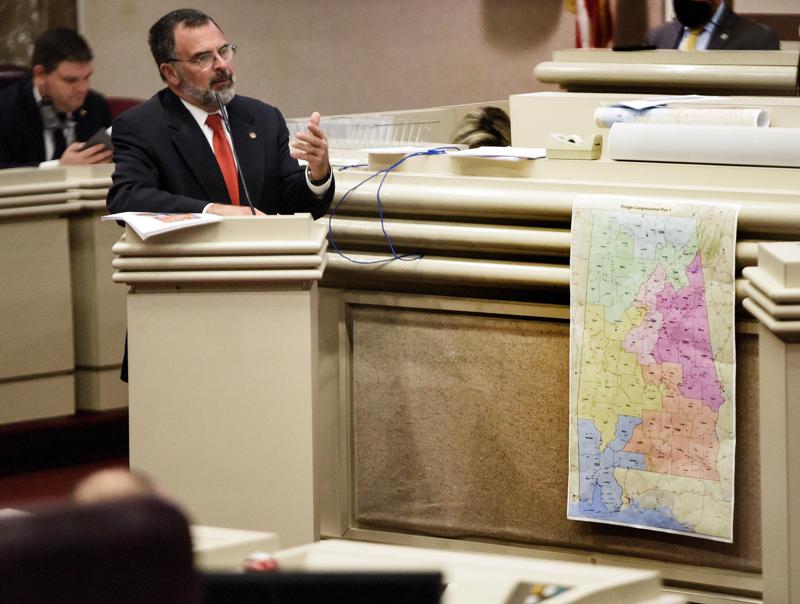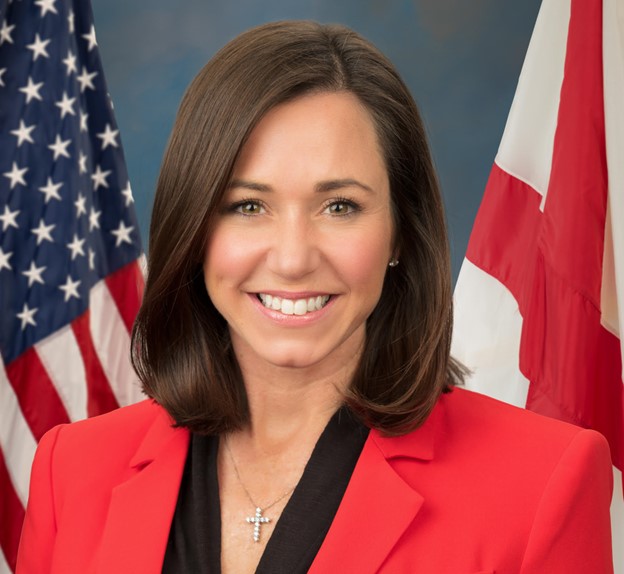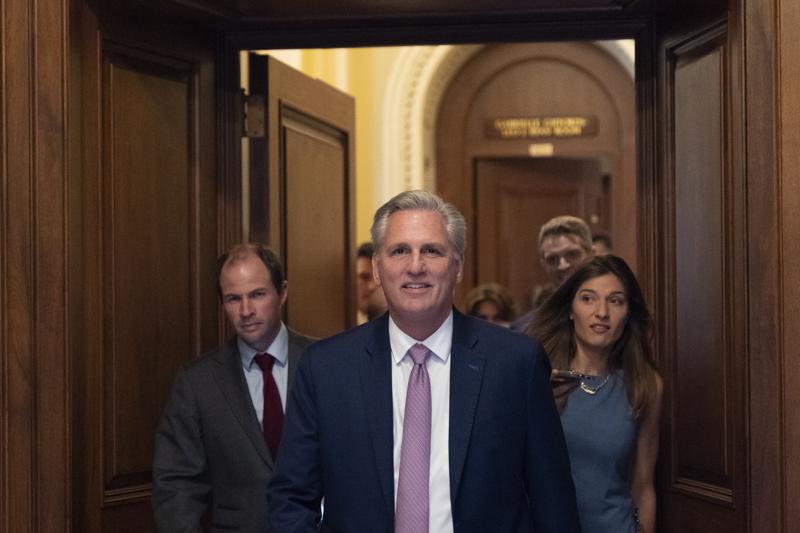U.S. Supreme Court denies bid by Alabama lawmakers in redistricting fight

The U.S. Supreme Court won’t intervene in the fight over Alabama’s congressional maps. On Tuesday, the court denied a bid by state lawmakers for another look at the fight about the state having a second Black majority congressional district. Several groups sued to overturn the state’s 2021 congressional maps, which had one of seven districts majority Black. It was a last-ditch effort by the state to keep maps drawn during July’s special session and rejected by a three-judge federal panel earlier this month. The U.S. District Court will pick between three congressional maps drawn by a court-appointed special master and a cartographer. All three will create Black-majority districts and be a likely pickup for Democrats. “This is a victory for all Americans, particularly voters of color, who have fought tirelessly for equal representation as citizens of this nation,” former Attorney General Eric Holder said in a release. “Even with this court’s landmark decision to uphold Section 2 of the Voting Rights Act, Alabama Republicans have defied court orders at every turn by refusing to enact a map that gives Black Alabamians the opportunity to elect a candidate of their choice in two districts. “These shameful, odious efforts to diminish the rightful voting power of Black Alabamians have finally been defeated. As a result, we will see more representative maps in places that were once thought to be unreachable in the fight for fairness: Alabama, Louisiana, and Georgia. Justice has prevailed.” On June 8, the U.S. Supreme Court issued a decision in Allen v. Milligan that said Alabama’s previously-drawn map violated the Voting Rights Act and ordered new maps that create an “opportunity district” for minority voters to cast ballots for the candidates of their choice. Republished with the permission of The Center Square.
Senators Katie Britt and Pete Ricketts introduce bill to strengthen oversight of U.S.-China science and technology agreements

U.S. Senator Katie Britt (R-Alabama) recently joined Senator Pete Ricketts (R-Nebraska) and 14 colleagues in introducing the Science and Technology Agreement Enhanced Congressional Notification Act. The bill would strengthen oversight of science and technology agreements (STAs) between the U.S. and the People’s Republic of China (PRC) by requiring the Secretary of State to provide comprehensive details to Congress about any new, renewed, or extended agreement and establishing a minimum 30-day Congressional review period. This transparency and accountability provision would include thorough national security risk assessments, human rights considerations, and consistent monitoring mechanisms. “It is simply common sense that proper Congressional oversight be conducted over any science and technology agreement the United States makes with the Chinese Communist Party,” said Sen. Britt. “The CCP is our greatest geopolitical and national security threat, and everything they do is as our adversary. The FBI has said that they open a new counterintelligence case against China about twice per day. From stealing our intellectual property and spying on our children through TikTok, to buying up American farmland and engaging in unfair trade practices that undercut Alabama steelmakers and shrimpers, we must hold the CCP accountable. We accomplish this through strength, not continued weakness.” “The Biden administration has failed to stand up to the Chinese Communist Party time and time again,” Sen. Ricketts said. “There is no daylight between the Communist regime and the private sector in the People’s Republic of China. The CCP will manipulate or disregard rules to gain technological and military advantages that put our national security at risk. Congressional oversight is necessary before we enter into science and technology agreements with our chief adversary. As the administration attempts to negotiate a stronger agreement, it should have to show its work. This bill would make sure that happens.” Joining Senators Britt and Ricketts in co-sponsoring this legislation were Ranking Member of the Committee on Senate Foreign Relations Jim Risch (R-Idaho) and Senators Deb Fischer (R-Nebraska), Tim Scott (R-South Carolina), Marco Rubio (R-Florida), John Cornyn (R-Texas), Todd Young (R-Indiana), Joni Ernst (R-Iowa), Steve Daines (R-Montana), Cynthia Lummis (R-Wyoming), James Lankford (R-Oklahoma), Thom Tillis (R-North Carolina), Ted Cruz (R-Texas), Ted Budd (R-North Carolina), and Mitt Romney (R-Utah). The bill prohibits the Secretary of State from renewing or extending the STA until he has provided Congress with at least 30 days to review the full text of the agreement as well as a detailed justification for the STA, including an explanation as to why such agreement is in the national security interests of the United States. The Secretary of State would also have to provide Congress with an assessment of the risks and potential effects of such an agreement, including any potential for the transfer under such agreement of technology or intellectual property capable of harming the national security interests of the United States. In addition, the bill requires that the Secretary provide a detailed justification for how the Secretary intends to address human rights concerns in any scientific and technology collaboration proposed to be conducted under such agreement, as well as an assessment of the extent to which the Secretary will be able to continuously monitor the commitments made by the PRC under such agreement. If this legislation is actually passed by Congress and signed into law by the President, once enacted, it would require the Secretary to provide Congress with the necessary reporting requirements listed above within 60 days of enactment, or any existing STA with the PRC will be revoked. U.S. Representative Andy Barr (R-Kentucky) has introduced companion legislation in the House of Representatives. Since the U.S.-China Science and Technology Agreement was originally signed in 1979, China has progressed technologically at a rapid pace and has achieved parity with the United States in many areas. The agreement has been renewed about every five years since then. It serves as the framework that facilitates research cooperation between the governments of the United States and PRC and academic institutions in both countries. The STA was last renewed in 2018 and was set to expire last month. However, the Biden administration recently extended the STA for another six months. There are ongoing concerns that research partnerships organized under the STA have strengthened the PRC’s military-industrial complex and potentially could be used to develop technologies that could later be used against the U.S. In one glaring example, in 2018, under the STA, the National Oceanic and Atmospheric Administration (NOAA) organized a project with China’s Meteorological Administration to launch weather balloons to study the atmosphere. Just a few months ago, similar balloon technology was used to surveil U.S. military sites on U.S. territory. A U.S. fighter aircraft had to shoot the balloons down – likely after the balloons had passed on valuable intelligence about U.S. military bases, including ICBM sites. Katie Britt was elected to the Senate in 2022. To connect with the author of this story or to comment, email brandonmreporter@gmail.com.
Daniel Sutter: Tennis superstars

Novak Djokovic’s recent U.S. Open title extended his record for career tennis grand slam victories to 24. He follows Roger Federer and Rafael Nadal, who broke this record with totals of 20 and 22. These achievements illustrate some economics of superstars and competitions. The career dominance of these stars runs counter to expectations for a mature sport. Tennis stars have earned fame and fortune for decades. Top athletes whose skills suit tennis should all be playing, producing competitive balance. By contrast, suppose tennis was only played in England. The top 20 players would come from a small sample of world athletes and may only include one true superstar talent. After a sport goes worldwide, the top 20 players could all be superstar talents. Coaching and training should also close the gap. With no coaching, the players with naturally perfect swings will dominate. Technology can now detail the perfect swing, grip, and footwork, which can be taught to all top players. Training and nutrition help top players maintain peak performance longer, helping stars win additional majors later in their careers. But this increases the number of stars playing at a high level, offsetting the career effect. Also, the big pries attracting top athletes to the sport might lead some stars to retire early to enjoy their money instead of maintaining intense training. The structure of tennis tournaments advantages top players relative to golf. Tennis tournaments involve matches between two players. Superstars need not be better than every other competitor each day; they only need to be better than that day’s opponent. By contrast, the low score over four rounds wins a golf tournament. A top golfer who shoots the course record on Friday might well win the tournament. After a tennis player’s perfect quarterfinal match, their semi-final match begins all even. Tennis tournaments also advantage intimidating stars. A golfer can win a tournament without ever being paired with the top superstar. Djokovic wins a tournament unless some player across the net beats him. The structure of tournaments has been the same for decades, so the elements favoring tennis cannot explain the recent career grand slam records. Both tennis and golf exhibit what economists call superstar markets, where talent is rewarded differently than in most labor markets. Labor market compensation normally depends on the value workers produce for businesses, called the marginal value product. It equals the worker’s contribution to production (the marginal product of labor) multiplied by the price of the good the worker makes. All labor market employment is voluntary, and businesses are not charities. Workers must create $20 per hour of value to be paid this amount. Competition for workers bids wages up to the marginal value product. A worker who is 10 percent more productive than another normally makes 10 percent more. But in sports – and especially tennis and golf – enormous earnings differences exist between the top players and “average” pros. For example, the 2023 top PGA golf money earner made seven times more than the 51st-ranked earner ($21 million vs. $3 million). The top earner is not seven times better than any PGA tour professional. What gives? As economist Sherwin Rosen first showed, sometimes relative productivity matters more than absolute productivity. In sports, victory goes to the better competitor, and many rewards go to the winners. The margin between victory or defeat is often small and the players delivering that extra performance can make a lot more. Superstar effects refer generally to markets where relative performance matters and are observed outside of sports, especially in entertainment, law, and CEOs in business. When people want the best lawyer or best CEO, bidding can skew compensation significantly. Are enormous differences in compensation and fame based on small differences in performance fair? I have merely explained and not justified superstar effects. But the star system emerges from voluntary exchanges in the market and ultimately reflects our preferences. And young athletes train very hard in pursuit of superstardom. Daniel Sutter is the Charles G. Koch Professor of Economics with the Manuel H. Johnson Center for Political Economy at Troy University and host of Econversations on TrojanVision. The opinions expressed in this column are the author’s and do not necessarily reflect the views of Troy University.
Terri Sewell applauds new special master drawn congressional maps

On Monday, the proposed remedial Alabama congressional redistricting maps were released by Special Master Richard Allen. The three maps were filed with the three-judge panel in the ongoing voting rights case – Allen versus Milligan. Congresswoman Terri Sewell – Alabama’s only Democratic member of the congressional delegation – applauded the new maps. “Today, despite the relentless efforts by state officials to delay, obstruct, and defy, we are one step closer to having fair congressional maps in the State of Alabama,” Rep. Sewell said in a statement. “I applaud the special master for submitting three strong proposals which prove what we have long known to be true; the creation of two districts where Black voters can elect a candidate of their choice was possible from the very beginning.” “I look forward to the adoption of one of these proposals and I remain ready and eager to continue representing the great people of Alabama’s 7th Congressional District,” Sewell concluded. All three maps create two majority-minority districts. All three are variations on the same general theme: · The maps divide Mobile County into a majority White section that remains in Alabama’s First Congressional District and a majority Black section that is moved into Alabama’s Second Congressional District. · The maps divide the Wire Grass community between the First and Second Congressional Districts. · The maps stretch a redrawn First Congressional District from the Mississippi line in Mobile County to Baldwin County across Mobile Bay and then along the Florida line all the way to the Georgia line. · The Second congressional district would stretch from downtown Mobile to Montgomery and all the way to the Georgia line. · The Second and Seventh Congressional Districts would both be majority minority. · Congressman Barry Moore (R-AL02) and Congressman Jerry Carl (R-AL01) would both live in the same district. If both seek a third term, there is a strong likelihood that they could face each other in the 2024 Republican primary on March 5. “The three remedial plans submitted to the United States District Court for the Northern District of Alabama by the Special Master represent a chance to restore the power of the vote for Black Alabamians, and all Alabamians,” said Alabama House Minority Leader Anthony Daniels (D-Huntsville. “All three maps place the majority of the City of Mobile in a proposed Congressional District 2. This is a clear rejection of the State’s attempts at subversion, and a rebuke of the manner in which the legislative majority twisted our shared history into a shield for discrimination.” Rep. Jerry Carl was less than enthusiastic by the news. “Today, a federal court released three proposed maps that will split south Alabama into two different congressional districts. Once again we have seen activist judges overstep their roles,” Carl said on Twitter. The three-judge panel will consider which of three maps to adopt on October 3. The state of Alabama has previously objected to dividing Mobile County and the Wiregrass region, arguing that the two communities of interest should not be divided. Both Jefferson and Tuscaloosa Counties were divided in the 2012 maps, the 2021 maps, and the July map prepared by the Legislature in a special session. The three special master maps also divided Jefferson and Tuscaloosa Counties into different districts, and there has been no objection by the state or the court to dividing those communities of interest along racial lines. The Alabama Attorney General’s office has asked the U.S. Supreme Court to put a stay on the three-judge panel redistricting so that the state can once again present its case to the Supreme Court. The Court has agreed to hear the state’s emergency appeal. Milligan and the other plaintiffs have asked the court to reject the state of Alabama’s request for a stay on the new districts. They argue that both the 2021 map and the July map violate the Voting Rights Act of 1965. The three-judge panel rejected Alabama’s request to hold up the redistricting. Democrats and their civil rights group allies hope that they can use the courts as a tool to flip as many as 15 congressional districts from Republican to Democratic, thus likely regaining control of the U.S. House of Representatives no matter what happens with the Senate or the presidential election next year. Qualifying for Congress with the two major parties begins in mid-October and ends on November 10, with both major party primaries being held on March 5. To connect with the author of this story or to comment, email brandonmreporter@gmail.com.
Special primary voters in House District 16 and 55 go to the polls today

The Alabama Democratic Party is holding a special primary election in Alabama House District 55 today. Meanwhile, the Alabama Republican Party is holding a special primary election in Alabama House District 16. Both elections are to fill vacancies in the Alabama House of Representatives. In House District 55, State Rep. Fred “Coach” Plump (D-Fairfield) resigned his seat and pled guilty to corruption-related charges in a federal public corruption probe, The candidates running in the HD55 Democratic primary are Kenneth Coachman, Travis Hendrix, Ves Marable, Cara McClure, Phyllis E. Oden-Jones, Sylvia Swayne, and Antwon Bernard Womack. Kenneth Coachman is a former two-term Mayor of Fairfield. Travis Hendrix is a former law enforcement officer and is widely seen as an up-and-coming politico with several key endorsements, including from BCA and House Minority Leader Anthony Daniels. Ves Marable is a Fairfield City Councilor and the choice of the Alabama Democratic Conference. Cara McClure is a community activist best known as the co-founder of the Birmingham chapter of Black Lives Matter. Phyllis E. Oden-Jones is a Fairfield City Council member and a retired Birmingham police detective. Sylvia Swayne is a recent college graduate and a transgender. She has the support of the LGBTQ+ community. Antwon Bernard Womack is a labor organizer and perennial candidate. No Republican qualified to run in this heavily Democratic majority-minority district. A special Democratic primary runoff, if necessary, will be held on October 24. The special general election is scheduled for January 9, 2024. House District 55 is in Jefferson County. In House District 16, State Representative Kyle South (R-Fayette) resigned his office to accept a position as the President and CEO of the West Alabama Chamber of Commerce. The House District 16 candidates are Bryan Brinyark, Brad Cox, Greg Fanin, Floyd Rogers Jr., and Mike Simpson. Greg Lowery was previously a candidate but was disqualified by the Alabama Republican Party because he previously ran for Fayette County Probate Judge as a Democrat. Bryan Brinyark is an attorney. Brad Cox is a banker, former high school teacher, and Fayette County Commissioner. Cox is the AEA-funded candidate. Greg Fanin is retired from the military after serving in the U.S. Army and Air Force. Floyd Rodgers, Jr. is the Alabama Communities of Excellence coordinator for the City of Fayette. Rodgers is also a minister. Mike Simpson is an attorney and former law enforcement officer who worked for the City of Bessemer and the Alabama Bureau of Pardons and Paroles. A special Republican primary runoff, if necessary, is scheduled for October 24. There is no Democratic primary in HD16 as John Underwood is the only Democrat to qualify and, thus, the Democratic nominee. Underwood will face the eventual Republican nominee in the January 9 general election. House District 16 includes Fayette County and portions of northern Tuscaloosa County and western Jefferson County. During the last legislative session, the Alabama House of Representatives divided 77 Republicans to 28 Democrats. You must have a valid photo ID to participate in any Alabama election. There is no same-day registration in Alabama, and you must vote at the polling place you are assigned. Polls will open at 7:00 a.m. and close at 7:00 p.m. Both districts should have representation in place in time for the 2024 regular legislative session. The representatives elected will serve the remainder of this term and then face voters again in 2026. To connect with the author of this story or to comment, email brandonmreporter@gmail.com.
Congress faces looming government shutdown

By Casey Harper | The Center Square Lawmakers are scrambling to avoid a partial government shutdown this week. Funding for the federal government runs out at the end of September, Saturday at midnight, and lawmakers are still far from getting agreement on a deal that President Joe Biden can sign into law. In the House, Speaker Kevin McCarthy, R-Calif., has been unable to persuade enough conservative Republicans to back his push for a Continuing Resolution, a temporary funding measure to buy time. McCarthy may have to work with Democrats to get enough votes on a C.R., but that could jeopardize his position as Speaker. McCarthy won the speakership after a grueling series of votes, and House Republicans have been adamant that they can vote to remove McCarthy at any time. Senate Democrats have already begun shifting blame onto House Republicans and McCarthy, pointing out House Republicans had time to pass individual spending bills but did not get them done in time. “I’ve never seen a group that is as hellbent on a shutdown as these crazy MAGA Republicans, that small group,” Senate Majority Leader Chuck Schumer, D-N.Y., told CNN, referring to holdout House Republicans. Schumer is working on passing a temporary funding measure that can be sent to the House and give Republicans a tough choice: let the government shut down or pass the Senate’s hard-to-stomach version of the spending measure. Ukraine funding in particular has become a divisive issue that could kill any funding bill. Democrats and many Republicans support it, but a growing contingent of Republicans say taxpayers should no longer keep sending the large sums overseas. McCarthy has blasted some of the holdouts, for whom Ukraine funding has been a sticking point. “This is a whole new concept of individuals that just want to burn the whole place down,” McCarthy told reporters last week. Meanwhile, Senate Democrats are unlikely to favor any measure McCarthy can get passed that appeases conservative Republicans. While many essential government services would continue operating, many others across a range of federal agencies would be paused if the government shuts down. Democrats in the past have blasted Republicans for threatening the paychecks of those employees, though they will get back pay once the government reopens. The shutdown would affect over 2 million civilian employees and military members. “Nearly a hundred thousand of my constituents won’t get paid during a shutdown. It’s a disaster for Northern Virginia,” Rep. Don Beyer, D-Va., wrote on social media. “They have families who depend on them, and they don’t deserve this. Republicans must honor the Speaker’s agreement with the President, and prevent a shutdown.” Former President Donald Trump, who has emboldened some Republican holdouts with his support, argued to Republicans that Biden would be blamed if the government shut down. “The Republicans lost big on Debt Ceiling, got NOTHING, and now are worried that they will be BLAMED for the Budget Shutdown,” Trump wrote on social media Sunday evening. “Wrong!!! Whoever is President will be blamed, in this case, Crooked (as Hell!) Joe Biden!” “WE NEED NEW, & REAL, REPUBLICAN LEADERSHIP IN THE UNITED STATES SENATE, NOT A CLONE OF MITCH, & WE NEED IT NOW!!!” Trump added. Meanwhile, fiscal experts warn that the federal government’s continued debt spending is unsustainable and will continue to have major consequences for taxpayers. Earlier this month, news broke that the U.S. national debt surpassed $33 trillion, the highest ever. The U.S. Congressional Budget Office released earlier this month its estimate of the federal deficit 11 months into the fiscal year. That deficit hit about $1.5 trillion. At the same time last year, the deficit was under one trillion dollars. As The Center Square previously reported, within a few years the cost of interest payments on the national debt will soon cost taxpayers more than spending on national defense. In fact, interest payments on the national debt are on pace to become the largest expense for the federal government. A key impact of that debt spending is higher inflation, which has soared in recent years and spiked again in August. Debt spending is offset in part by printing more money, increasing the money supply and inflation as a result. Food and gas prices in particular have risen. The U.S. Department of Agriculture projects food prices will continue to rise through 2024. Republished with the permission of The Center Square.
Alabama Power volunteers support annual coastal cleanup; Renew Our Rivers, Mobile River event coming up

Alabama Power volunteers in the Mobile area recently joined with volunteers from Airbus to do their part to keep Alabama’s coastal waters clean as part of the annual Alabama Coastal Cleanup. Volunteers with the Mobile and Plant Barry chapters of the Alabama Power Service Organization (APSO) participated in the cleanup and also helped sponsor the event. They were paired with Airbus volunteers, and together they helped clean sections of Meaher State Park in Spanish Fort and along the Mobile Causeway. Touted as the state’s largest annual volunteer event, more than 108,000 volunteers have participated since Alabama joined the International Coastal Cleanup initiative in 1987. Multiple organizations, businesses, and individual volunteers took part in the cleanup on Sept. 16 at more than two dozen sites along the Gulf Coast and Mobile Bay. The sites included neighborhoods, parks, riverbanks, and shoreline areas in Baldwin and Mobile counties. APSO is a repeat volunteer partner in the Coastal Cleanup. “I love to serve others in our community, and APSO provides an outlet for me to do just that,” said Sara Taylor, the APSO member who led the group’s cleanup effort. “Keeping our hometown environment clean is one of the best ways I know to give back,” Taylor added. “There are so many needs right here in our community, and we all need each other. Being a member of APSO has afforded me the opportunity to join with others to do something good.” Alabama Power and other Mobile-area partners will be conducting a cleanup along the Mobile River October 4-5 as part of the Renew Our Rivers campaign. Since it began in 2000 with a community cleanup along the Coosa River, Renew Our Rivers has grown to become one of the largest volunteer river cleanup initiatives in the Southeast. Learn more about Renew Our Rivers and see the latest schedule of cleanups here. The Alabama Coastal Cleanup is coordinated through the Alabama Department of Conservation and Natural Resources and Alabama People Against A Littered State (PALS). Recycling efforts connected to the cleanup are conducted in coordination with the Osprey Initiative, a local environmental contractor. Learn more about community volunteerism by Alabama Power employees and retirees at powerofgood.com. for more information about the company’s environmental stewardship efforts, click here. Republished with the permission of
California ban on standard-capacity gun magazines overturned

By Kenneth Schrupp | The Center Square Federal judge Roger Benitez overturned California’s ban on standard-sized ammunition magazines, with California Attorney General Rob Bonta filing an immediate notice of appeal. The injunction on the ban will be stayed for 10 days, which means that the ban’s overturn will likely not take effect as the decision is appealed. “Unless we enshrine a Right to Safety in the Constitution, we are at the mercy of ideologues like Judge Benitez,” said California Governor Gavin Newsom in a public statement responding to the decision. “This is exactly why I’ve called for a Constitutional amendment, and this is why I’ll keep fighting to defend our right to protect ourselves from gun violence.” Standard-capacity magazines have been illegal to manufacture, import, keep, or offer for sale, give, or lend since 2000, and illegal to purchase or receive in any way since 2013. Proposition 64, passed by California voters in 2016, made it illegal to possess even legally-acquired standard-capacity magazines with more than 10 rounds under the rationale such a measure would limit mass shootings. Anyone who did not turn in their standard-capacity magazines by July 1, 2017, could have faced up to a year in prison before an earlier injunction by Benitez. The most popular firearm sold in 2022, a Sig Sauer P320 pistol, comes with a 15-round magazine except where otherwise limited, such as in California. “There is no American history or tradition of regulating firearms based on the number of rounds they can shoot, or of regulating the amount of ammunition that can be kept and carried,” wrote Benitez in his latest ruling. Benitez first struck down Proposition 63’s rule in June 2017, right before enforcement began, noting only six mass shootings between 2006 and 2013 used the banned magazines, and that “entitlement to enjoy Second Amendment rights and just compensation is not eliminated simply because they possess ‘unpopular’ magazines holding more than 10 rounds.” In 2018, a 2-1 panel of the Ninth Circuit Court affirmed Benitez’s ruling on the confiscations. In 2019, Benitez ruled against the ban on the acquisition of standard-capacity magazines, citing varying outcomes of women’s self-defense cases where having additional bullets made the difference between life and death. This decision was upheld in a 2020 panel of the Ninth Circuit Court, then overturned by an en banc decision of the same court in 2021. The United States Supreme Court vacated the Ninth Circuit Court’s en banc decision in 2022 and remanded it back to Benitez for a new decision. Benitez’s latest ruling, if upheld in the appeals process, could allow for the resumption of legal sale of standard-capacity magazines in California. Republished with the permission of The Center Square.


